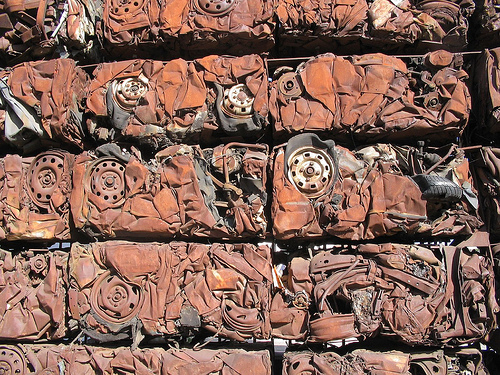
Cars Crushed Into Cubes
If you read the PDF of the house bill you will notice that it outlines a clear procedure that each vehicle that is traded in under the official “Consumer Assistance to Recycle and Save Program’’ must have both the trade-in and new purchase Vehicle Identification Number (V.I.N.) recorded on the voucher. Then the dealer is responsible for disposing of the trade-in vehicle in accordance to all applicable laws and regulations. Since the bill calls for the V.I.N of the trade-in to be disclosed, there really is no wiggle room for the dealer to take the trade and resell it. It is intended that all vehicles that are traded in will be destroyed.
This is where car collectors get up in arms; some even say that this is being blown out of proportion by car collectors, but we need to take a step back and look at the ramifications of this “voluntary” program. Let’s be realistic, is it possible that someone can take a rare Classic car and trade it in under this program? The simple answer—Yes. Would it make sense to do so? No. Why do I say no? In general most collector car vehicles are worth more than the voucher, but the fear is that people will just go find any old “clunker” and use it as a trade-in under this new program.
The other scenario that is possible is that we will loose major portions of cars from the ‘70s and ‘80s that are collectible to new generations. A 1984 Lincoln Town car may not be collectible to the whole of the United States, but for some people they will want to collect and preserve a piece of American Automotive history. This is also true for the Z cars of the’80s and even the Chrysler “K” series cars. In fact, there is a whole club dedicated to the “K” cars and their preservation.

Dodge Shelby Charger
Bottom line—the “Cash for Clunkers” bill does set some precedents for the mandatory destruction of operational vehicles. It also leaves an important question unanswered—is it more environmental. Considering the research that is out there my vote is no. Be sure to tell your House and Senate Representatives how you feel.
Be sure to check out our partner site coverage: House Agrees on Cash-For-Clunkers Bill, House Bill Cash For Clunkers Meets Resistance From Senate; Bill May Be Dead on Arrival and Cash-For-Clunkers: Finally, Movement.












